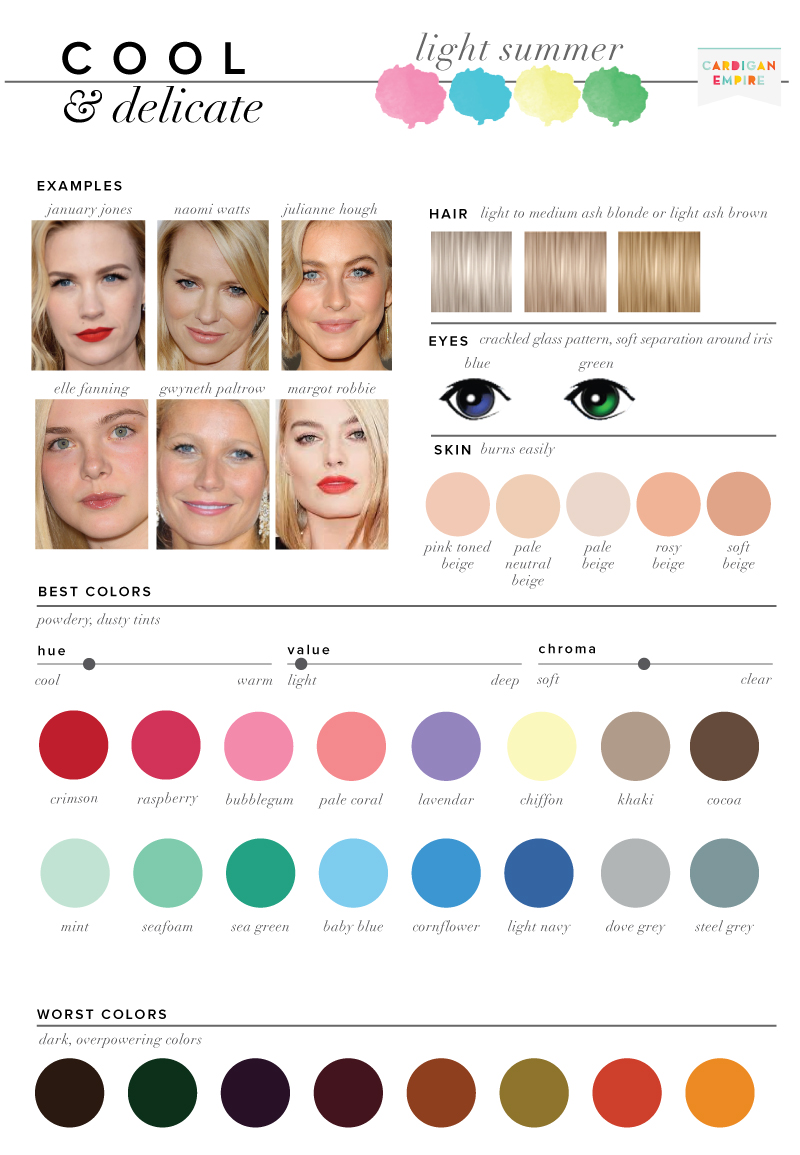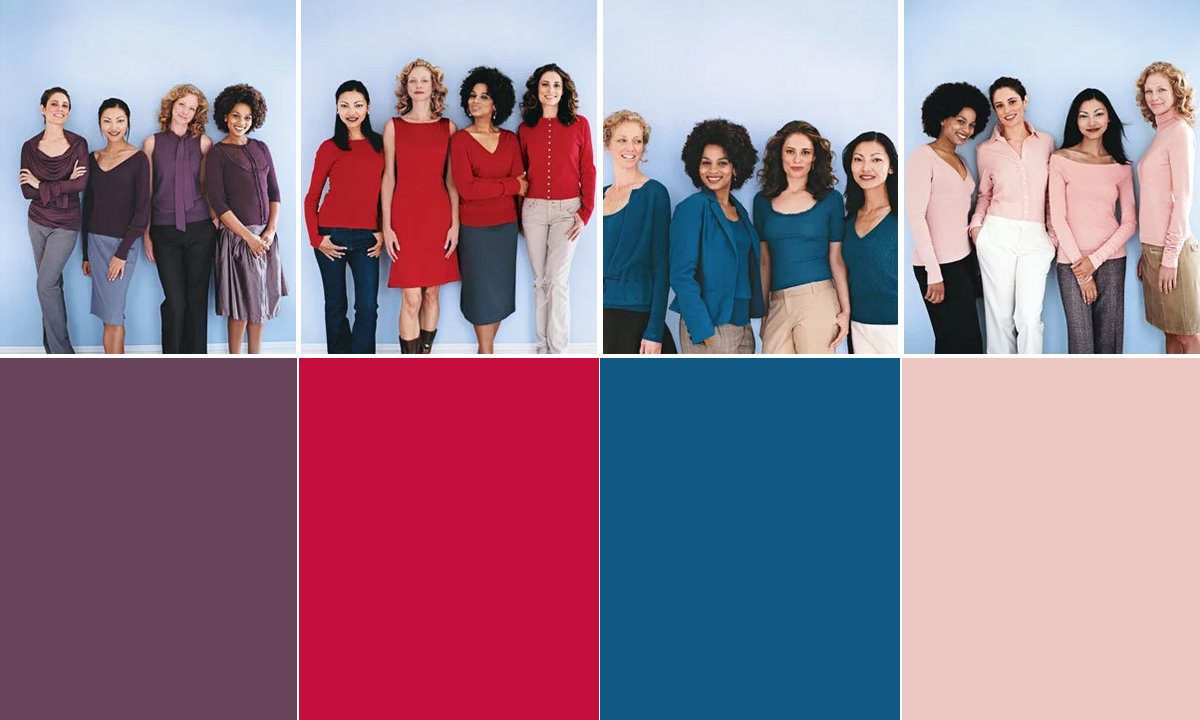Have you ever stood in front of a rack of clothing, overwhelmed by the endless sea of colors, wondering which ones would make your pale skin glow? You’re not alone. The perfect color can make you feel radiant and confident, while the wrong one can leave you looking washed out and dull. But fear not, because understanding the nuances of color theory can unlock a world of flattering hues for your unique complexion.

Image: cardiganempire.com
The art of finding the right colors for pale skin goes beyond simply avoiding black or white. It delves into the undertones of your skin, understanding the subtle differences between cool, warm, and neutral tones, and how these affect the way colors interact with your complexion. This guide will walk you through the science behind color theory, reveal the most flattering shades for your pale skin, and provide practical tips for choosing outfits and makeup that elevate your natural beauty.
Understanding Your Skin Tone: Cool, Warm, or Neutral?
The first step in discovering your most flattering colors is to identify your skin tone. It’s not about the overall lightness or darkness of your skin, but rather the underlying color – cool, warm, or neutral.
Cool Undertones:
- Veins: Appear blue or purple
- Skin: Often has a pink or rosy hue
- Hair: Usually ashy blonde, brown with cool highlights, or black with blue undertones
- Sunburn: Tends to burn easily and turns reddish
Warm Undertones:
- Veins: Appear green or olive
- Skin: Often has a yellow or golden hue
- Hair: Typically golden blonde, brown with warm highlights, or reddish brown
- Sunburn: Tends to tan easily and turns golden brown

Image: effortlessgent.com
Neutral Undertones:
- Veins: Appear a mix of blue and green
- Skin: Can have both pink and golden tones
- Hair: Ranges from light blonde to dark brown, often with a balanced mix of cool and warm highlights
- Sunburn: May burn or tan depending on the sun’s intensity
If you’re unsure about your skin tone, try the “jewelry test.” Place a silver and gold necklace against your skin. The color that looks most harmonious and flattering reveals your underlying undertone: silver for cool tones, gold for warm tones, and both looking good for neutral tones.
Color Theory for Pale Skin: Finding Your Perfect Palette
Now that you know your skin tone, let’s delve into the color wheel and understand how colors interact with your complexion. Pale skin typically reflects light differently than warm skin tones, and certain colors enhance its natural beauty while others can make it look washed out.
Cool Skin Tones:
Embrace these colors that complement your rosy undertones:
- Blues: The cooler shades of blue, like navy, cobalt, and sapphire, will create a striking contrast against your skin and accentuate your eyes.
- Greens: Emerald, teal, and forest green will add vibrancy to your complexion, making you appear more alive and radiant.
- Purples: Lavender, plum, and amethyst will create a sophisticated and elegant look, enhancing your natural cool tones.
- Pinks: Rose, magenta, and fuchsia can be flattering, but choose softer shades that complement your skin’s cool undertones.
- White: Opt for crisp, cool white tones that will brighten your complexion and make you look fresh and radiant.
Warm Skin Tones:
These colors will bring out the natural warmth and radiance in your skin:
- Yellows: Gold, mustard, and amber will create a warm glow and accentuate your golden undertones, making you look sun-kissed.
- Reds: Burgundy, brick red, and coral will add warmth and dimension to your complexion, enhancing your natural radiance.
- Oranges: Tangerine, peach, and apricot will create a cheerful and vibrant look, brightening your skin and making you appear healthy and glowing.
- Browns: Choose warm browns like chocolate, caramel, and ochre for a sophisticated and earthy look. Avoid cool browns as they can make your skin appear dull.
- Ivory: A creamy, warm ivory will complement your skin tone and create a luxurious and elegant look.
Neutral Skin Tones:
You’re lucky! You can wear a wide range of colors, but these shades are typically most flattering:
- Jewel Tones: Ruby, emerald, sapphire will complement your neutral undertones and create a rich and luxurious look.
- Earthy Tones: Olive green, terracotta, and beige will bring out your natural warmth while maintaining a balanced and sophisticated aesthetic.
- Neutrals: Black, white, gray, and black will create a classic and timeless look that complements your skin’s natural balance.
Beyond Colors: Choosing the Right Shade
It’s not just about the color itself; the shade is crucial too. A too-bright shade can wash you out, while a too-dark shade can make you look muddy. Here are some tips for choosing the right shade:
- Consider your hair color: Brighter shades tend to work well with lighter hair, while deeper shades complement darker hair.
- Experiment with swatches: Don’t just rely on seeing a color on a hanger. Try swatches against your skin to see how it interacts with your undertones.
- Look in natural light: Artificial light can distort colors, so it’s best to judge how a color looks in natural daylight.
- Think about your desired look: Are you going for a bold and dramatic look or a soft and romantic one? Your desired look will inform your shade choices.
Creating a Harmonious Wardrobe: How to Incorporate These Tips
Now that you’ve identified your skin tone and learned about flattering colors, it’s time to apply this knowledge to your wardrobe.
1. Invest in Versatile Basics:
Start with a foundational wardrobe of neutral pieces, such as a classic white shirt, a black blazer, and a pair of dark denim jeans. These can be styled with pops of color for endless outfit possibilities.
2. Incorporate Statement Pieces in Flattering Colors:
Add color and personality with statement pieces that complement your skin tone. This could be a bright scarf, a colourful dress, or a bold jacket.
3. Mix and Match Colors Within Your Palette:
Don’t be afraid to experiment with different shades within your color palette. For example, if you’re a cool-toned brunette, you could pair a lavender top with a navy skirt or a teal dress with plum shoes.
4. Embrace Seasonal Colors:
Seasonal color palettes can be a great source of inspiration. For example, warm colours like reds, oranges, and yellows are perfect for autumn, while cool shades like blues, greens, and purples are ideal for winter.
5. Use Accessories Wisely:
Accessories can add a pop of color without being overwhelming. A bright scarf, a colourful handbag, or a statement necklace can instantly elevate any outfit.
Beyond Clothing: Color Theory in Makeup
The same principles that apply to clothing also extend to makeup. Choosing the right colors for your eye shadow, blush, and lipstick will enhance your natural features and create a harmonious look.
Cool Skin Tones:
- Eyeshadow: Opt for cool shades like gray, silver, icy blue, and plum.
- Blush: Pink, rose, and cool-toned peach blushes will create a natural flush.
- Lipstick: Choose cool-toned reds, pinks, and berry shades.
Warm Skin Tones:
- Eyeshadow: Go for warm shades like gold, bronze, peach, and copper.
- Blush: Peach, apricot, and coral blushes will complement your warm undertones.
- Lipstick: Choose warm-toned reds, oranges, and corals.
Neutral Skin Tones:
- Eyeshadow: You can wear a wide range of shades, but jewel tones like emerald, ruby, and sapphire are particularly flattering.
- Blush: Both cool and warm shades will work well for you, but keep the shade light and natural.
- Lipstick: Choose classic reds, pinks, nudes, and corals.
What Colors Look Best On Pale Skin
Conclusion
Navigating the world of color can be overwhelming, but by understanding your skin tone, embracing flattering hues, and experimenting with different shades, you can unlock your personal style potential. This guide is just a starting point; the most important aspect is finding what works best for you. So, experiment, have fun, and celebrate the beauty of your unique complexion!





